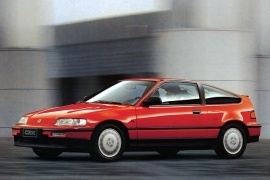
HONDA Civic CRX
Generations Timeline, Specs and Pictures

When Honda introduced the second generation of the Civic CRX on the market, it redefined the pocket-rocket standards and was a direct threat to hot-hatches.
The Japanese carmaker didn’t have big or supercharged engines. It relied on its proven VTEC technology and its engineers’ ingenuity to develop quick vehicles. The Civic CRX was based on the same platform as the Civic, hence the Civic badge, but other than that, it was a different vehicle.
With its short length and unusual shape, the CRX was easy to recognize. Its profile started with a narrow front, a short hood, and a raked windscreen. The greenhouse featured an unusual profile, with a sloped roof extended to the back of the car with a heavily stippled glass area, which was part of the liftgate. Unlike its predecessor, the 1988 model featured an additional vertical glass panel to improve rear visibility. It was less than 150” (3.8 meters) long and just 50” (1.27 meters) tall.
Inside, the carmaker installed very low-mounted seats at the front. There were two seats in the back in theory, but those were large enough to fit a toy dog and a briefcase. At least, the rear bench’ seatback was folded down, increasing the almost non-existent trunk space, where the carmaker had to install a space-saving tire to fit it inside.
The real magic of the car was the technical platform with its independent suspension in all corners. It sported a double-wishbone suspension in all corners and, for the top-spec version, disc-brakes all around. Under the hood, Honda offered a choice of three engines: one for the masses, one economical, and the marvelous, 100 hp/liter, naturally aspirated 1.6-liter unit. For the U.S. market, the latter was detuned by ten hp to 150 due to lower-grade gasoline.























































